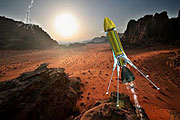- Number 331 |
- February 21, 2011
Fleet of nuclear-powered Mars Hoppers could bring back a piece of Mars

INL's Center for Space
Nuclear Research designed
nuclear-powered "hoppers"
that could be more efficient
than rovers — a few dozen
could map the entire Martian
surface in just a few years.
Future Mars surface missions could cover more ground with a platform that can hop great distances in the planet's thin atmosphere and weak gravity. Since summer 2009, researchers and student fellows at the Center for Space Nuclear Research at DOE’s Idaho National Laboratory have been fleshing out designs for a nuclear-powered Mars hopper that can examine one Martian site, jump to another, and repeat, hundreds of times.
One hopper design is about as big and heavy as an adult emperor penguin and capable of traveling almost 200 times as far as twin Mars rovers Spirit and Opportunity did in their first five years on Mars.
The lean, long-lived hoppers are designed to wring as much science and exploration as possible out of every ounce. They don't have to carry fuel with them; they can suck up the carbon-dioxide-rich Martian atmosphere and use it as a propellant. On cue, stored heat from a radioisotope power source hits the propellant and rockets the hopper in an arcing path toward its next landing site.
The CSNR Mars hopper team has generated a variety of hopper designs tailored to transport different payloads. The payloads range in size from 10 kilograms — the mass of a medium-size dog — to about 200 kg, the mass of either Spirit or Opportunity with a big dog sitting on top.
A single rocket launch from Earth could deploy several hoppers at once. A fleet of hoppers could collect Martian rock and dust samples at the source and deliver them to an Earthbound rocket. The CSNR team plans to keep its hoppers simple and deploy them in large numbers so they can cast a wide net in a search for traces of Martian life.[Nicole Stricker, 208.526.5955,
nicole.stricker@inl.gov]
